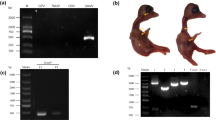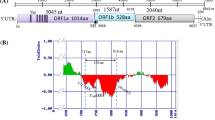Abstract
In the current study, the complete genome sequence of a member of the family Astroviridae isolated from pigeons was determined through genetic characterization and phylogeny analysis. The isolated genome sequence was proposed to be that of pigeon avian nephritis virus (ANV), whose genome structure and characteristics were similar to previously reported avian astroviruses. The sequenced ssRNA genome comprises 6928 nucleotides, excluding the poly(A) tail, and contains three open reading frames. Phylogenetic analysis using a partial nucleotide sequence of the polymerase gene and the entire amino acid sequence of the full-length capsid protein revealed that pigeon avian nephritis virus is closely related to the previously published ANV, especially to the Japanese G-4260 and Chinese strains. This investigation provides information on the sequence and genetic characteristics of this virus and contributes to a better understanding of pigeon ANV and the possible occurrence of astrovirus transmission between chickens and pigeons.


Similar content being viewed by others
References
Baxendale W, Mebatsion T (2004) The isolation and characterisation of astroviruses from chickens. Avian Pathol 33:364–370
Cattoli G, Toffan A, De Battisti C, Salviato A, Terregino C, Capua I (2005) Astroviruses found in the intestinal contents of guinea fowl suffering from enteritis. Vet Rec 156:220
Connor TJ, McNeilly F, McFerran JB, McNulty MS (1987) A survey of avian sera from Northern Ireland for antibody to avian nephritis virus. Avian Pathol 16:15–20
Day JM, Spackman E, Pantin-Jackwood M (2007) A multiplex RT-PCR test for the differential identification of turkey astrovirus type 1, turkey astrovirus type 2, chicken astrovirus, avian nephritis virus, and avian rotavirus. Avian Dis 51:681–684
Decaesstecker M, Charlier G, Peeters J, Meulemans G (1989) Pathogenicity of fowl enteroviruses. Avian Pathol 18:697–713
Frohman MA, Dush MK, Martin GR (1988) Rapid production of full-length cDNAs from rare transcripts: amplification using a single gene-specific oligonucleotide primer. Proc Natl Acad Sci USA 85:8998–9002
Fu Y, Pan M, Wang X, Xu Y, Xie X, Knowles NJ, Yang H, Zhang D (2009) Complete sequence of a duck astrovirus associated with fatal hepatitis in ducklings. J Gen Virol 90:104–108
Gough RE, Borland ED, Keymer IF, Stuart JC (1985) An outbreak of duck hepatitis type II in commercial ducks. Avian Pathol 14:227–236
Guy JS, Miles AM, Smith L, Fuller FJ, Schultz-Cherry S (2004) Antigenic and genomic characterization of turkey enterovirus-like virus (North Carolina, 1988 isolate): identification of the virus as turkey astrovirus 2. Avian Dis 48:206–211
Imada T, Yamaguchi S, Mase M, Tsukamoto K, Kubo M, Morooka A (2000) Avian nephritis virus (ANV) as a new member of the family Astroviridae and construction of infectious ANV cDNA. J Virol 74:8487–8493
Imada T, Yamaguchi S, Miura N, Kawamura H (1980) Antibody survey against avian nephritis virus among chickens in Japan. Natl Inst Anim Health Q (Tokyo) 20:79–80
Jindal N, Patnayak DP, Chander Y, Ziegler AF, Goyal SM (2010) Detection and molecular characterization of enteric viruses from poult enteritis syndrome in turkeys. Poult Sci 89:217–226
Le Cann P, Ranarijaona S, Monpoeho S, Le Guyader F, Ferre V (2004) Quantification of human astroviruses in sewage using real-time RT-PCR. Res Microbiol 155:11–15
Mandoki M, Bakonyi T, Ivanics E, Nemes C, Dobos-Kovacs M, Rusvai M (2006) Phylogenetic diversity of avian nephritis virus in Hungarian chicken flocks. Avian Pathol 35:224–229
Marlier D, Vindevogel H (2006) Viral infections in pigeons. Vet J 172:40–51
McNulty MS, Allan GM, Connor TJ, McFerran JB, McCracken RM (1984) An entero-like virus associated with the runting syndrome in broiler chickens. Avian Pathol 13:429–439
Mendez E, Arias CF (2007) Astroviruses. In: Knipe DM, Howley PM (eds) Fields Virology. Lippincott Williams and Wilkins, Philadelphia, pp 981–1000
Pantin-Jackwood MJ, Spackman E, Woolcock PR (2006) Molecular characterization and typing of chicken and turkey astroviruses circulating in the United States: implications for diagnostics. Avian Dis 50:397–404
Rivera R, Nollens HH, Venn-Watson S, Gulland FM, Wellehan JF Jr (2010) Characterization of phylogenetically diverse astroviruses of marine mammals. J Gen Virol 91:166–173
Saitou N, Nei M (1987) The neighbor-joining method: a new method for reconstructing phylogenetic trees. Mol Biol Evol 4:406–425
Shirai J, Tanimura N, Uramoto K, Narita M, Nakamura K, Kawamura H (1992) Pathologically and serologically different avian nephritis virus isolates implicated in etiology of baby chick nephropathy. Avian Dis 36:369–377
Smyth VJ, Jewhurst HL, Adair BM, Todd D (2009) Detection of chicken astrovirus by reverse transcriptase-polymerase chain reaction. Avian Pathol 38:293–299
Todd D, Smyth VJ, Ball NW, Donnelly BM, Wylie M, Knowles NJ, Adair BM (2009) Identification of chicken enterovirus-like viruses, duck hepatitis virus type 2 and duck hepatitis virus type 3 as astroviruses. Avian Pathol 38:21–30
Todd D, Trudgett J, McNeilly F, McBride N, Donnelly B, Smyth VJ, Jewhurst HL, Adair BM (2010) Development and application of an RT-PCR test for detecting avian nephritis virus. Avian Pathol 39:207–213
Wang QH, Kakizawa J, Wen LY, Shimizu M, Nishio O, Fang ZY, Ushijima H (2001) Genetic analysis of the capsid region of astroviruses. J Med Virol 64:245–255
Zhao W, Hua XG, Yuan CL, Cui L, Shan TL, Dai XQ, Zhu AL, Yu Y, Zhu CX, Yang ZB (2011) Sequence analyses of the representative Chinese-prevalent strain of Avian Nephritis Virus in Healthy Chicken Flocks. Avian Dis 55:65–69
Yamaguchi S, Imada T, Kawamura H (1979) Characterization of a picornavirus isolated from broiler chicks. Avian Dis 23:571–581
Acknowledgments
The authors thank Dr Yu-hong Su for providing statistical analysis and excellent technical assistance. The diarrhoeic stool samples from pigeons were kindly provide by the Animal Center for Disease Control in Shanghai, China.
Author information
Authors and Affiliations
Corresponding author
Rights and permissions
About this article
Cite this article
Zhao, W., Zhu, A.L., Yu, Y. et al. Complete sequence and genetic characterization of pigeon avian nephritis virus, a member of the family Astroviridae . Arch Virol 156, 1559–1565 (2011). https://doi.org/10.1007/s00705-011-1034-8
Received:
Accepted:
Published:
Issue Date:
DOI: https://doi.org/10.1007/s00705-011-1034-8




